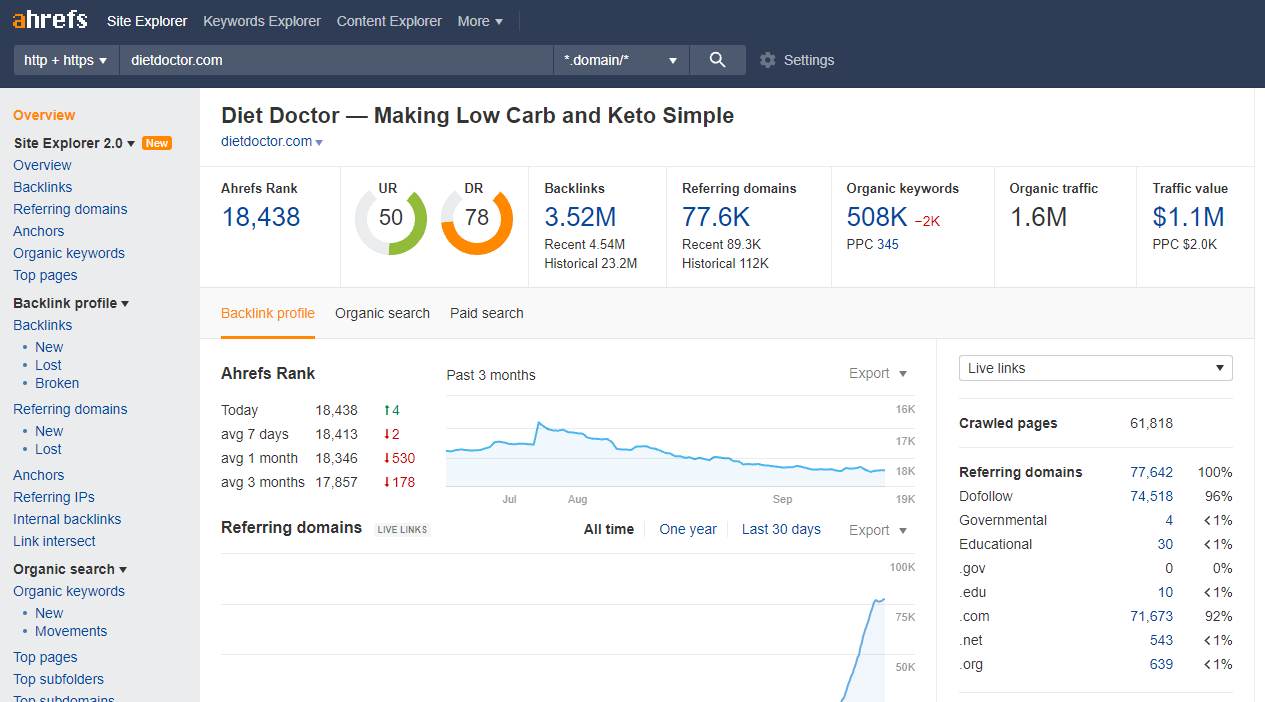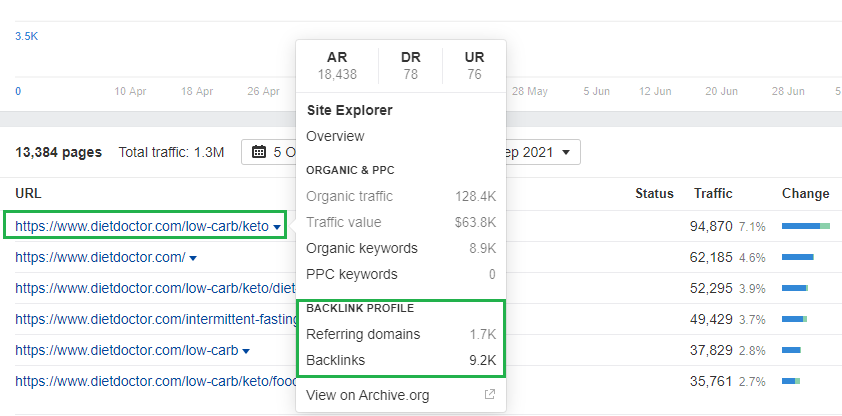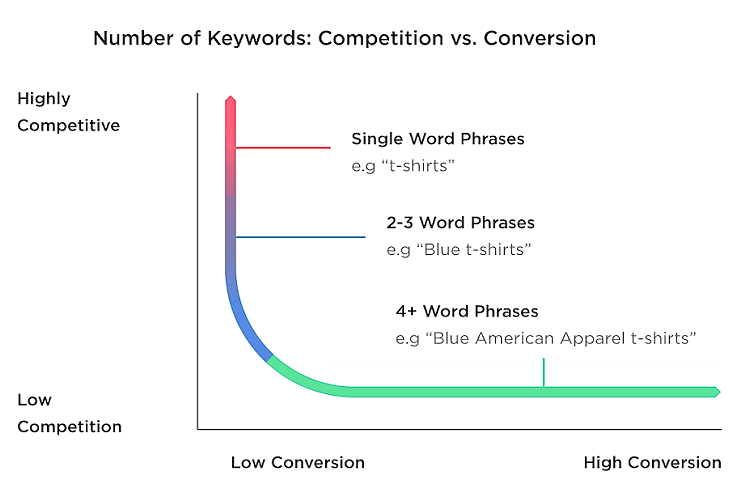One of the best ways to get traffic to your website without spending extra money is through keyword research.
More specifically, targeting the right “long tail keywords” with your content can make all the difference when it comes to the amount of traffic you get from the search engines.
Not sure exactly what that means? No problem.
Here is a practical guide to how keyword research can bring you more free (organic) traffic than you’ve thought possible.
Keyword Research Basics
Let’s briefly set the stage for this topic. When we talk about a “keyword” we are talking about any search term that gets searched in Google (or another search engine.)
Some keywords get searched all the time. For example “how to lose weight” is searched about 110,000 times per month in the US according to Google’s Keyword Planner.
On the flip side, on any given day 15% of Google searches are things that have never been searched before. That’s about 500 million searches per day that are brand new to Google.
Somewhere in between these super competitive keywords and these very obscure, never-before-searched keywords are what we call “long tail keywords.”
Long Tail Keywords Explained
Long tail keywords tend to be more specific searches that are typically searched less often, by people who are about to make a buying decision.
In our earlier example, “how to lose weight” is not a long tail keyword. However, as that person learns more about their weight loss options and becomes more informed, they will often start searching for more detailed, specific things about weight loss.
Perhaps they’ll search for things like:
- “does P90X work?”
- “low carb diet grocery list”
- “lose weight without running”
These are examples of long tail keywords. What we’ve found is that by targeting the right long tail keywords on your website, you can start increasing traffic and more importantly, draw in people who are very targeted for your business.
How To Get Traffic With Long Tail Keywords
Once you’ve setup your website, you need to start adding content such as new pages and blog posts to your site.
But the question is “posts about what?”
This is where keyword research and focusing on the right long tail keywords comes into play. If you’re just starting a site in the nutrition space, your chances of ranking on page 1 of Google for “how to lose weight” are similar to your odds of winning the lottery without buying a ticket.
Unfortunately this is where a lot of new site owners mess up. They see that this phrase gets searched 110,000 times per month and think that’s what they should focus on.
The better approach is to focus on ranking a bunch of pages for related long tail keywords that may only get searched 5,000, 500, or even 50 times per month.
Here is how you can start:
Check The Keywords That Your Competitors Rank For
Before we talk about brainstorming keyword ideas on your own, why not start with what is already working for sites similar to yours?
One of the beautiful things about tools like Ahrefs is the ability to do a little spying on your competition.
Sticking to our nutrition example, find another health site that you’d consider “competition” or maybe just a site you’d admire.
Then, simply search that competitors domain in Ahrefs to get started. I’m going to start by analyzing “dietdoctor.com” to see what I come up with:

Once I click on “search links,” I’ll then see the main overview of their site including the total number of backlinks and the domain rank:

Next, I’m going to click on “Top Pages” near the top of the left-hand navigation. What “Top Pages” does is show you what their most popular pages are, based on the traffic, value and the number of backlinks to that page.
Here are the top pages for dietdoctor.com:

As you spot some of these keywords, jot them down so you can use them later to find even more related ideas. These are great idea starters for finding more long tail keywords because you know they are topics that other people like to share and link back to.
Bonus Tip:
Besides “idea starters,” you should also be looking for opportunities to directly “one-up” your competition.
For instance, you may find a page that does really well for a competitor, but you know that you could make something better. Let’s say the Diet Doctor’s page about “Keto diet” for beginners is short, and not all that special.
You could put together a more thorough, better looking beginners guide to Keto.
The great thing is, you can again use Ahrefs to quickly find out exactly where all of the Diet Doctor’s 9.2K links to that page are coming from and reach out to those sites about your newer, better resource on this same topic.
Let me show you the steps to follow.
Step #1:
From the “Top Pages” screen, make sure you click on the “backlinks” link at the top so you can see the detailed link results. (See image below)
Step #2:
Click on the number of total backlinks, in this case I am going to click on “9.2K” to see the links to the Keto page.

Step #3:
Next, you’ll see a huge list of pages that are linking directly to the Diet Doctor’s Keto page. Start at the top and work your way down, since Ahrefs sorts by putting the highest ranked pages at the top.

Step #4:
Click on the URL of the site linking to the Diet Doctor, and get a feel for the context of the link. Perhaps it is a list of resources on LCHF diets, which is great news for you. Once your LCHF page is complete, you can then go to the “contact” page of that website and let them know about a new, fantastic addition to their list!
Step #5:
Remember that for larger lists, like this one with over 6,000 links, you can click the “export” button at the top of the list and save this for later. This will allow you to keep track of your outreach in a spreadsheet and make notes on who you’ve contacted, and what responses you’ve received.
While this process can be time consuming, it is time well spent because you are using intelligent outreach. After all, every one of these sites has already linked to a page just like yours, so sending them a quick heads up about your similar resource makes a lot of sense.
“They Ask, You Answer” – Keyword Brainstorming Technique
“They ask, you answer” is a phrase that I’ve borrowed from Marcus Sheridan. Marcus applied the concepts we’re talking about to his small, failing pool company and completely turned things around.
Marcus talks a lot about simply listening to your customers, and taking on the mindset of a teacher and not a salesman.
“They ask, you answer” simply means to start by brainstorming and writing down all the questions you get from customers and prospective customers on a daily basis.
The idea is that if they’ve asked you that question, other people are asking the same question in Google.
So take every question that you’ve heard, and make each one it’s own blog post on your website. If other staff members contribute, this could easily give you 50 – 100 content ideas to start with.
Find The Keywords That People Are Actually Searching For
Once you’ve done all the questions you know, it’s time to start finding other keyword ideas based on the data that is available to you.
As I mentioned earlier, Google makes the average search volume of any keyword readily available, but just knowing how often something is searched is only half the battle.
The other half is being able to analyze your competition.
Ideally, you want to find keywords that have lower quality competition in the top 10 results of Google. After all, if you can’t get to the first page then you are practically invisible.
If you are struggling to come up with other keyword ideas, here are some simple steps to follow:
Step #1:
Look for forums in your niche. This can be done by searching Google for “Your Niche + Forum.” Although forums aren’t cutting edge, they are full of active discussions from people in your industry. Simply scan the list of topics or “threads” and write down any interesting keywords or topics you see.
Step #2:
Search top selling products and Kindle books on Amazon for your industry. I particularly like looking at the top Kindle books in my categories of interest because the titles are often full of keywords that I can use.
There are thousands of results, but just from the very first one I see “clean eating” and “healthy snacks” as a couple of interesting keyword ideas to explore. Write down all of the eye-catching keywords you see.
Step #3:
Once you’ve got a list of “starter keywords,” it’s time to get even more ideas for similar long tail keywords. We do this by using software – Long Tail Pro.
I start by adding a few keywords I found in my searching, such as “clean eating,” “healthy snacks,” etc. and then let the software generate a bunch of similar ideas.
Step #4:
Finally, look through the list of generated keywords and click on any of them that seem relevant to your business. By clicking on the keyword, you’re able to quickly analyze the current top 10 results in Google for that keyword.
This gives you an indication of the strength of those results and lets you know how difficult it might be for you to get into the top 10 yourself.
In short, you are looking for results from low quality, low authority sites that aren’t doing a very good job of targeting the keyword. These are the “low hanging fruit” of your niche and give you an easier path to start pulling in organic traffic.
Once you’ve done the research, here’s how you bring it to life on your website:
How To Target Longtail Keywords in Your Content
Let’s continue with our earlier example in the nutrition space. I used “low carb diet grocery list” as an example of a long tail keyword and as it turns out, it actually fits our criteria rather nicely.
After plugging it into our tool (shown above), I see that it gets searched 260 times per month and Long Tail Pro is telling us that the competitiveness rating is 26 (on a scale of 1 – 100), which means it is pretty low.
Now that I have a good keyword, I’d next go into my management tool (WordPress, Squarespace, etc.) to create a new page/post on this topic.
When I do, I’m going to use my exact keyword in both my page title and the heading that goes on the page.
This is important in helping Google understand what your page is about, and in this case we are focused on a very specific phrase that we hope to rank for. If you are a WordPress user, consider the Yoast SEO plug-in which will make sure you are putting your keyword in all the right places.
While “keyword stuffing” is a bad idea, you do want to use your keyword again in the heading of your page, and maybe a couple of times in the content of your page as it makes sense.
Remember that your focus should be on providing value to your human visitors first and foremost.
From here it’s important to create the best darn low carb grocery list you can. Make sure that when you compare your page to the others in the top 10 currently that you are making the best resource and deserve to rank #1!
Once you’ve added your content, simply publish your content to make it live. However, don’t expect to shoot up the rankings overnight!
In fact, it may take months in some cases for a newer site to start ranking well in the search engines. Be patient and understand that it’s normal. You’re best bet is to “rinse and repeat.”
Keep finding low competition keywords and adding pages or blog posts that zero in on that very topic.
A Word Of Caution on Content
Finding the best long tail keyword in the world isn’t going to help if your content is mediocre. The same goes with using Ahrefs for the “skyscraper technique” described above.
You have to deliver great content.
Take Action!
We covered a lot, so let’s summarize an action plan so you can start growing:
- Analyze your top competitors in Ahrefs to see their “Top Pages”
- Jot down competitor keywords you notice, and look for any “skyscraper” opportunities to one-up their popular content
- Make a running list of questions you hear about your business
- Answer those questions on your website, one question per page/post
- Find other keyword ideas to target (using keyword tool like Long Tail Pro)
- Create content that is laser-focused on your keyword, and is of high quality to the end user.
- Rinse and repeat. Remember that this is a marathon and not a sprint.
If you can do those 7 things I’m confident you’ll see success. I’ve done it personally and I’ve seen other businesses do it time and time again with fantastic results!
Now get to work!




